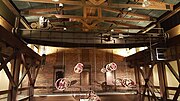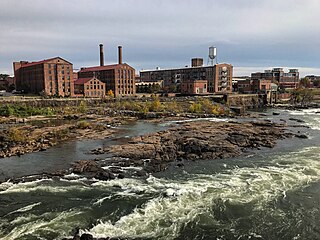
Columbus is a consolidated city-county located on the west-central border of the U.S. state of Georgia. Columbus lies on the Chattahoochee River directly across from Phenix City, Alabama. It is the county seat of Muscogee County, with which it officially merged in 1970. Columbus is the second-largest city in Georgia, and fields the state's fourth-largest metropolitan area. According to the 2020 United States census, Columbus has a population of 206,922 residents, with 328,883 in the Columbus metropolitan area. The metro area joins the nearby Alabama cities of Auburn and Opelika to form the Columbus–Auburn–Opelika Combined Statistical Area, which has an estimated population of 486,645 in 2019, according to the U.S. Census Bureau.
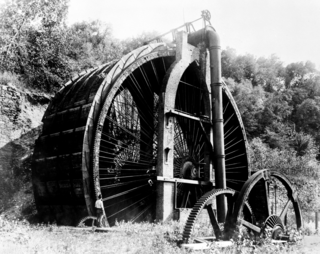
The Burden Iron Works was an iron works and industrial complex on the Hudson River and Wynantskill Creek in Troy, New York. It once housed the Burden Water Wheel, the most powerful vertical water wheel in history. It is widely believed that George Washington Gale Ferris Jr., inventor of the Ferris wheel, had occasion to observe the wheel while a student at Rensselaer Polytechnic Institute. The iron works site was listed on the National Register of Historic Places as an archaeological site in 1977. The Burden Ironworks Office Building was previously listed in 1972.

The Tredegar Iron Works in Richmond, Virginia, was the biggest ironworks in the Confederacy during the American Civil War, and a significant factor in the decision to make Richmond its capital.

Meramec State Park is a public recreation area located near Sullivan, Missouri, about 60 miles from St. Louis, along the Meramec River. The park has diverse ecosystems such as hardwood forests and glades. There are over 40 caves located throughout the park, the bedrock isdolomite. The most famous is Fisher Cave, located near the campgrounds. The park borders the Meramec Conservation Area.

The Augusta Canal is an historic canal located in Augusta, Georgia, United States. The canal is fed by the Savannah River and passes through three levels in suburban and urban Augusta before the water returns to the river at various locations. It was devised to harness the water power at the fall line of the Savannah River to drive mills, to provide transportation of goods, and to provide a municipal water supply. It is the only canal in the US in continuous use for its original purposes of providing power, transport, and municipal water.
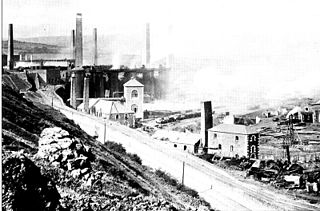
The Cyfarthfa Ironworks were major 18th- and 19th-century ironworks in Cyfarthfa, on the north-western edge of Merthyr Tydfil, in South West Wales.

Joseph Neel Reid, also referred to as Neel Reid, was a prominent architect in Atlanta, Georgia, in the early 20th century as a partner in his firm Hentz, Reid and Adler.

The Tannehill Ironworks is the central feature of Tannehill Ironworks Historical State Park near the unincorporated town of McCalla in Tuscaloosa County, Alabama. Listed on the National Register of Historic Places as Tannehill Furnace, it was a major supplier of iron for Confederate ordnance. Remains of the old furnaces are located 12 miles (19 km) south of Bessemer off Interstate 59/Interstate 20 near the southern end of the Appalachian Mountains. The 2,063-acre (835 ha) park includes: the John Wesley Hall Grist Mill; the May Plantation Cotton Gin House; and the Iron & Steel Museum of Alabama.
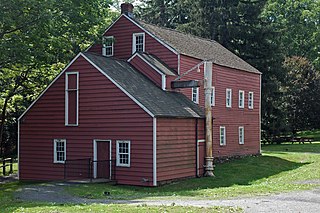
Speedwell Ironworks was an ironworks in Speedwell Village, on Speedwell Avenue, just north of downtown Morristown, in Morris County, New Jersey, United States. At this site Alfred Vail and Samuel Morse first demonstrated their electric telegraph. Speedwell Ironworks also provided most of the machinery for the SS Savannah, the first steamship to cross the Atlantic Ocean. The site is still open to the public, and has seven buildings on display. The site, now named Historical Speedwell, is a historic site of the Morris County Park Commission. It was designated a National Historic Landmark in 1974.

The United States Marine Hospital in Louisville, Kentucky, in the Portland neighborhood was built in 1845, and is considered by the National Park Service to be the best remaining antebellum hospital in the United States. Of the seven hospitals built in the mid-19th century by the Marine Hospital Service "for the benefit of sick seamen, boatmen, and other navigators on the western rivers and lakes." It is the only one still standing, even after surviving two tornadoes. The building has been extensively restored to match its appearance in 1899.

The Green–Meldrim House is a historic house at 14 West Macon Street, on the northwest corner of Madison Square, in Savannah, Georgia. Built in 1853, it was designated as a National Historic Landmark in 1976 as one of the American South's finest and most lavish examples of Gothic Revival architecture. The house is owned by the adjacent St. John's Episcopal Church, which offers tours and uses it as a meeting and reception space.

The Iron & Steel Museum of Alabama, also known as the Tannehill Museum, is an industrial museum that demonstrates iron production in the nineteenth-century Alabama located at Tannehill Ironworks Historical State Park in McCalla, Tuscaloosa County, Alabama. Opened in 1981, it covers 13,000 square feet (1,200 m2).

The John Winthrop Jr. Iron Furnace Site is a historic archaeological site at 61 Crescent Street, Quincy, Massachusetts. The site is called Braintree Furnace in some texts; the West Quincy location at the time of operation was in a part of Braintree, Massachusetts, that later became Quincy. Its importance lies in the fact that it was the first iron blast furnace established in what would become the United States. Furnace Brook, a stream which begins on the eastern slopes of the Blue Hills and meanders for about four miles from southwest to northeast through the middle of Quincy toward Quincy Bay, was named for the works site.

Downtown Columbus, Georgia, also called "Uptown", is the central business district of the city of Columbus, Georgia. The commercial and governmental heart of the city has traditionally been toward the eastern end of Downtown Columbus, between 10th Street and 1st Avenue. Recent developments, particularly between Broadway and 2nd Avenue, have expanded the boundaries of the "central" part of the neighborhood. The term "Downtown Columbus" can also mean this smaller, more commercial area, particularly when used in the context of the city's nightlife and restaurants

The Brierfield Furnace, also known as the Bibb Naval Furnace and Brierfield Ironworks, is a historic district in Brierfield, Alabama. The district covers 486 acres (197 ha) and includes one building and nine sites. It was listed on the National Register of Historic Places on November 20, 1974. The district is encompassed by Brierfield Ironworks Historical State Park.
Coopersville Ironworks Site (38CK2) and Susan Furnace Site (38CK67), also known as the Cherokee Ford Ironworks Site and Nesbitt Iron Manufacturing Co., is a historic archaeological site located near Gaffney, Cherokee County, South Carolina. The site includes the foundations of four large factory buildings, with a system of canal/sluiceways between them, and the remains of three iron furnaces. The outlying furnace, Susan Furnace, includes foundations, sluiceways, slag heaps, and adjacent ore pits. The complex is the largest and best preserved factory complex of any of the 19th century iron manufacturing companies of the region. The complex was developed between 1835 and 1843 by the Nesbitt Iron Manufacturing Company, the largest iron company in South Carolina. The Nesbitt Company was dissolved in the late 1840s, and the Swedish Iron Manufacturing Company of South Carolina operated the ironworks from 1850 until the American Civil War.

Cristo Rey Columbus High School is a private, Roman Catholic, co-educational high school in Columbus, Ohio, United States. It was established in 2013 and is located in the Roman Catholic Diocese of Columbus. It follows the Cristo Rey work-study model of education for students from low-income families.

The Gilmanton Ironworks Library is a historic library building at 10 Elm Street in the Iron Works village of Gilmanton, New Hampshire. Built in 1916–17, it was the first Colonial Revival library building in Belknap County. The building, still serving as a branch of the Gilmanton public library system, was listed on the National Register of Historic Places in 1989.
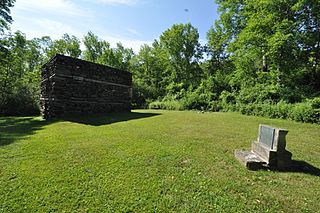
The Mount Riga Ironworks was one of the most successful manufacturers of iron in the late colonial and post-Revolutionary period of United States history. Located in the far northwestern Connecticut town of Salisbury, it produced high quality iron for use in military and domestic applications, and supported a community of 1,200 people. It declined in the mid-19th century, and was closed in 1847. Surviving elements include an early 19th-century cold blast furnace and other foundational and archaeological remains. Its site, now part of a large private holding owned by the Mount Riga Corporation, was listed on the National Register of Historic Places in 1994.
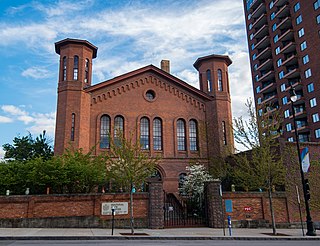
The Cultural Arts Center is a combination art gallery and teaching space, primarily for visual artists and crafters, in downtown Columbus, Ohio. It is a 38,500 square-foot space at 139 West Main Street, and is part of the city's Scioto Mile tourist district. Features of the space include a ceramics lab in the basement, with painting and weaving labs on upper floors. It offers community oriented arts classes at a variety of levels, and is also utilized as an events space.






